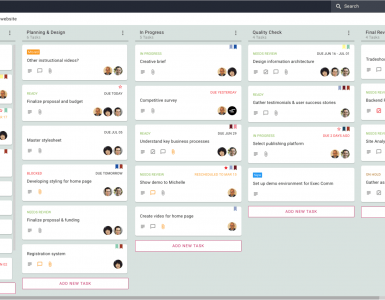Referrals are the sincerest form of flattery. They’re the result of a job well done, a happy client, and can be the beginning of your next big design project. It’s a beautiful thing when projects come full circle and new clients come in through word-of-mouth referrals. But how do you get an optimal clientflow?
Whether you realize it or not, every step of the process matters. Like, a lot.
It’s your response time to inquiries and how you deliver contracts.
It’s how you collect client input and process payments.
Plus, everything in between.
Luckily, it’s easier than you may think to exceed client expectations and get that referral engine firing. It takes a little thing called a clientflow.
What is a Clientflow?

A clientflow is the combination of the client journey and your workflow. It’s the whole process of providing services to clients and includes the work you do and the steps needed to get it done.
For instance, your clients usually need to select services, sign a contract, and provide input throughout the project. Meanwhile, you need to run your business and do all the actual design work.
Designers have a wide range of capabilities and expertise. So, for example, you might have one clientflow for a logo and branding project and another for a website redesign. The steps are often the same, but the experience may vary to suit each project or individual client.
Building effective clientflows is critical to managing your time, building strong client relationships, and successfully working for yourself. This is especially true when juggling multiple projects and deadlines.
A designer’s clientflow typically includes the following steps:
- Initial Contact
- Service Selection
- Contract Signing
- Invoice and Payment
- Communication and Work Process
- Service and Deliverable
- Renewal Decision
- Recommendation or Referral
Your Clientflow Step-by-Step:
1. Initial Contact
Referral or not, when potential clients reach out to you, it’s game time. This is your opportunity to showcase your work, communicate what you do, and make a strong first impression.
The easiest way to get clients in the door for many designers is with a contact form on their website or portfolio. This funnels new leads right into the next stage of the clientflow so there’s no lapse in communication.
From there, a timely response will build trust and get the relationship started on the right foot. And when you have a well-crafted clientflow, this response can be triggered automatically so you never miss an opportunity, even if you’re away from your computer.
The main purpose of your first interaction is to understand the client’s needs and make sure you’ll be a good fit. To do this, either include a calendar link to schedule a meeting or add a questionnaire in your initial response to gather this information upfront. Either way, the key is to give clients everything they need to move forward in a smooth experience that instills confidence and professionalism.
2. Service Selection
When clients are ready to get the ball rolling, pricing guides or service brochures help them understand what you offer, what it costs, and how it will meet their needs.
The more you customize your proposal (based on the info you just gathered), the more impressed they will be. Personalization leaves a powerful impression and shows you’re the right designer for the job.
With the right tools in place, it’s a breeze to offer this level of personalization at scale…
3. Contract Signing
Next, it’s time to put pen to paper.
It probably goes without saying, but you should always have clients sign a contract before paying (and before you start working) so the scope of work, pricing, timeline, expectations, and any other terms are crystal clear.
Legal contracts have a way of putting people on edge. But making this process as easy as possible takes the edge off. That’s why this should all happen online—and ideally, be integrated with the first payment (such as a deposit or retainer) to seal the deal.
After all, forcing clients to print, sign, scan and resend a contract adds friction and frustration to the process when you’re both eager to get started.
An ideal contract should also include your client’s service selection and any relevant clauses and terms.
Since law school likely wasn’t part of your design background, check out these free contracts for designers if you’re unsure where to start.
4. Invoice and Payment
A seamless online payment process is industry standard in today’s digital world. Don’t make clients look for a checkbook they haven’t seen since the Bush administration. And we’re not talking about your personal Venmo or PayPal account either. They’ll notice (and remember) if this step feels difficult, unofficial, or the slightest bit sketchy.
The payment experience needs to be simple, secure, and professional. Send an invoice that allows your clients to pay online quickly and with the card or bank account of their choice. It’s also important to have a payment solution that can handle recurring payments, automate reminders, and work nicely with the rest of your clientflow.
5. Communication and Work Process
Communication builds strong client relationships—especially in the world of design. It’s essential for project alignment, progress reporting, rounds of feedback, and overall sentiment. Make sure you’re consistently checking in with clients and meeting their needs every step of the way.
It helps to use a platform that gives you a holistic view of your work pipeline, customer journey, client communication, and project materials in one place. Bonus points if you set up automation to remove predictable bottlenecks.
6. Service and Deliverable
Your shiny new design work is ready for prime time. Nice work. If the project progressed with smooth communication throughout, everyone should be excited about the end result.
As your business grows, you might also consider bringing on partners to help you expand your offering (think animation, web development, photography, videography, etc.) if that aligns with your goals.
7. Renewal Decision
For some clients, the project you just completed is the tip of the iceberg. A new brand identity project might lead to a new website or ad campaign. They’ll consider every step of the clientflow when deciding to work with you again. But if you’ve exceeded expectations and have an established relationship, you’ll be a natural choice to tackle the next design needs that come up.
8. Making a Recommendation or Referral
If a client had a great experience, they’ll want to share it. And if your design is a highly visible asset such as a new logo or website, your client’s friends, colleagues, and associates may even ask who did such impeccable work. Boy, you’re good.
At the same time, it never hurts to be proactive. That’s why it’s smart to trigger an automated email at the end of a project to thank them for their business, ask for a friendly review, and keep you in mind for the future.
The Bottom Line

It’s not what you do, but how you do it. Client experience is everything.
The most talented designer on earth will still struggle without a system to handle these process steps.
The ability to craft a clientflow that anticipates your clients’ needs, removes friction, and leaves them impressed will dramatically propel your freelance business forward.
It also reduces the amount of time you spend on day-to-day tasks, so you can do more of what you love – design.
The Shameless Plug
Was this article describing the ideal clientflow for designers? Yes.
Was it describing the #1 clientflow platform that lets you create it? Also yes.
It’s called HoneyBook, and it lets you do all of the above. Get started for $1/mo for your first 6 months.
Ready to get hired? At Twine, we have dozens of top-quality jobs being posted each and every day. From design to marketing, development to copywriting – there’s a job ready for your skills. Join the marketplace of diverse creative talent here.








